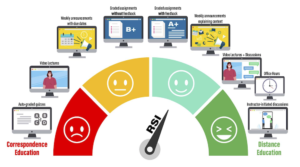
OSCQR – Standard #10
Course provides contact information for instructor, department, and program.
Review These Explanations
In addition to providing this information in the syllabus, including a contact information page in the course information documents opens opportunities for learners to contact and interact with course instructors, as well as department and program administrators. Be sure that there is a printable version of this information for learners to have on hand in case they are unable to access the online class and need to get in touch.
Interaction guidelines can be included along with contact information, and should indicate when and how the instructor prefers to be contacted. When posting department and program information, include hours of operation (if appropriate), and contact options if learners need to access to department or program resources outside of those hours.
Opening avenues for communication, and providing easy access to those channels supports learner-instructor interaction, and facilitates engaging in supportive contact and interaction, a key component of social presence. (Garrison, Anderson, & Archer, 2000).
Garrison, D. R., Anderson, T., & Archer, W. (2000). Critical inquiry in a text-based environment: Computer conferencing in higher education. The Internet and Higher Education, 2(2-3), 87-105.
Regular and Substantive Interaction (RSI)
How This Standard Supports RSI
This standard can support regular and substantive interaction compliance by providing contact information and information to clarify expectations, roles, and communication plans and channels, all of which are essential aspects of a well-designed online course. Directing learners to ask questions and interact with the instructor about these topics, such as in an online discussion forum, further supports RSI, and is a good general practice. Scheduling a specific instructor-facilitated discussion on these topics demonstrates compliance with RSI.
Refresh Your Course with These Ideas
General Suggestions
- Share expectations for contact including your your preferred, or required modes of contact.
- Provide information on regular office hours, how/where to ask questions, or get extra help, where to go for advisement, how to contact or access any department or program information or resources, etc.
- Share information about any required or optional online “office hours.”
- Mention the specific purposes of specific areas in the course for asking questions.
- If a student contacts you in a way or at a time that is not expected, or your preference, direct them to your preferred modes of contact.
- Support and Promote Diversity, Equity, Inclusion & Access.
- Be explicit about how you would like them to address you, and what information they may need to include in certain communications to make sure you know who they are and what course (or institutions) they may be from.
- Provide information on preferred ways of being addressed, including, for example, preferred pronouns, by first name, or preferred name, name prefixes, e.g., Dr., Mrs., etc., and ask learners how they would like to be addressed.
- Make sure your students know specifically what to expect in terms of your response time.
- Create a digital business card with your contact information and share it out via course announcements.
- Model the use of the features in your LMS for contact information, such as profiles.
- Include instructor, department, and program contact information in your syllabus and course information areas.
- Develop a Key Contacts list and link to it from the course home page, making it easy for learners to access, download, and print as they enter the learning space.
- Consider including an informal video introduction to the department and program staff, so that learners have a better idea of who they are reaching out to, and include that in the contact information area.
- Remember to update your contact information if you are traveling to another time zone, or your availability changes in any way during the delivery of your course.
- Recommend that learners print out Contact Information, so they have access to the information offline.
- If you are using a syllabus quiz, or scavenger hunt orientation activity, be sure to include finding and printing out the Contact Information provided in that activity!
Explore Related Resources
Share What You Know
OSCQR has been developed by a community of online practitioners interested in quality course design. There are numerous opportunities for community members to offer suggestions, donate resources, and help with future development.
Discuss this standard in the comments section at the bottom of this page.
Contribute your own ideas or refresh resources by filling out the OSCQR Examples Contribution Form.